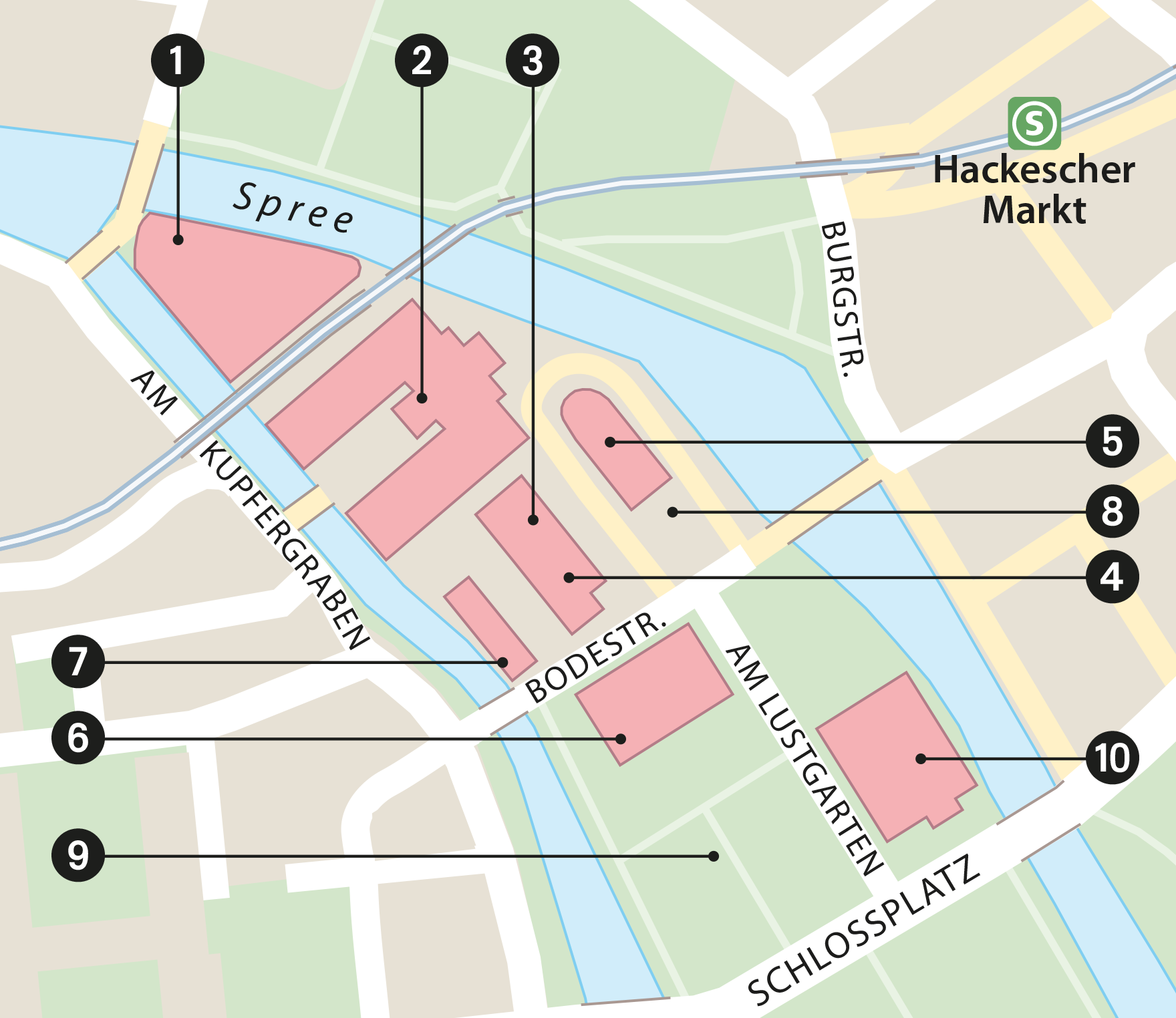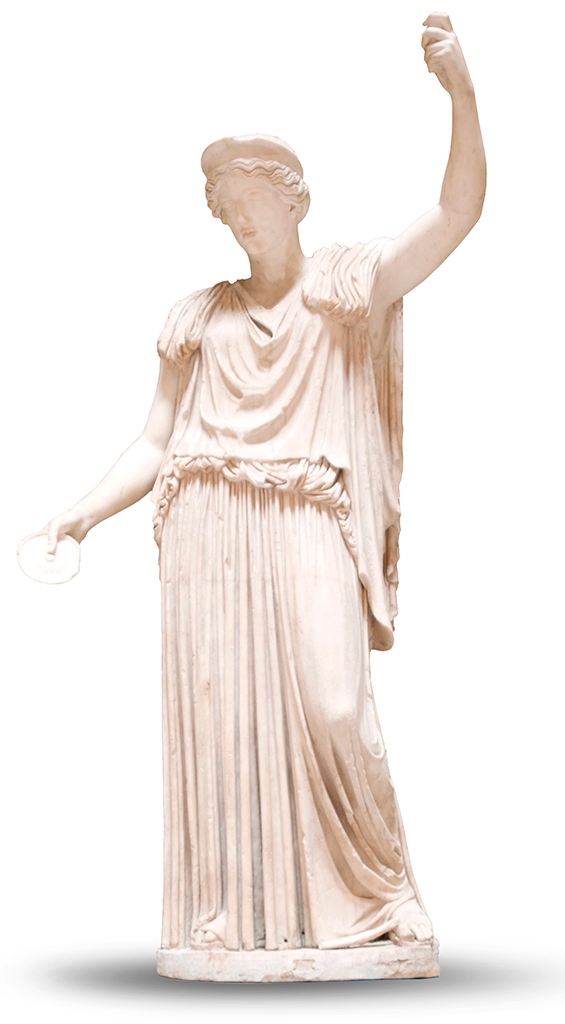Formed by the two arms of the Spree River, the Museumsinsel is home to the world’s most diverse yet coherent museum complex. Built between 1830 and 1930, the museums, which hold the Prussian royal collections of art and archaeology, were turned into a public foundation in 1918. Heavily damaged in World War II, the complex has since been restored and was declared a UNESCO World Heritage Site in 1999. From 2017, a conceptual path will link the individual museums on the island.
NEED TO KNOW
 030 266 424 242 • www.smb.museum • Open 10am–6pm daily, until 8pm Thu (most museums); sections of the Pergamonmuseum may be closed due to a phased remodelling until 2025 • Admission charge: €10–12 per museum; Museumsinsel day pass €18; 3-day Berlin Museum Pass €24; extra fee for some exhibitions; free for under-18s
030 266 424 242 • www.smb.museum • Open 10am–6pm daily, until 8pm Thu (most museums); sections of the Pergamonmuseum may be closed due to a phased remodelling until 2025 • Admission charge: €10–12 per museum; Museumsinsel day pass €18; 3-day Berlin Museum Pass €24; extra fee for some exhibitions; free for under-18s - Some of the museums have cafés, but the café at the Altes Museum is convenient as it is a little closer than the others to Karl-Liebknecht-Straße, the island’s main road.
- It’s best to set aside a whole day for the extraordinary collections of the Museumsinsel. There are several parks nearby in which you can take breaks. Sundays can be very busy with long queues and large groups.

1.Bode-Museum
Located at the northern tip of Museumsinsel, the Bode-Museum is a stately structure dominated by a cupola. The building holds the Sculpture Collection, the Museum of Byzantine Art and the Numismatic Collection, made up of a diverse collection of over 500,000 objects.

Bode-Museum
2.Pergamonmuseum
Built in 1909–30, this is one of the world’s most important museums of ancient art and architecture, with a vast collection of antiquities (for further details see Pergamonmuseum). The huge Ishtar gate dates from the 6th century BC.

Pergamonmuseum
3.Neues Museum
Spectacularly revamped by British architect David Chipperfield, the building itself is as fascinating as the exhibits. As well as the Museum of Pre- and Early History, the Ägyptisches Museum is also housed here.
4.Ägyptisches Museum
Housed within the Neues Museum, this museum features portraits of Egyptian royals and monumental architecture (for further details see Ägyptisches Museum).
5.Alte Nationalgalerie
First opened in 1876, the Old National Gallery was beautifully restored in the 1990s and now holds 19th-century sculptures and paintings, including works by Max Liebermann and Schadow (for further details see Alte Nationalgalerie).

Alte Nationalgalerie
6.Altes Museum
The first building to be completed on Museumsinsel in 1830, the Altes Museum resembles a Greek temple (for further details see Altes Museum and Lustgarten). Originally meant to hold paintings, it now houses the collection of Classical antiquities.

Altes Museum
7.James Simon Gallery
Named in honour of James Simon (1851–1932), a patron of the Berlin State Museums, this will open in 2018 and be the central entrance and visitor centre.
8.Colonnade Courtyard
This columned courtyard between the Alte Nationalgalerie and Neues Museum frames and connects the museums and provides an atmospheric venue for open-air concerts.
9.Lustgarten
This “pleasure park”, with a fountain in its centre, is located in front of the Altes Museum. The lawns are popular with tired visitors (for further details see Lustgarten).
10.Berliner Dom
Easily the island’s most overwhelming structure, this Baroque-style cathedral is unusually ornate for a protestant church. Organ concerts and services can be enjoyed in this exquisitely restored church (for further details see Berliner Dom).

Berliner Dom
MISSING TREASURES
During World War II, many of the island’s exhibits were hidden in underground bunkers. Some pieces of “Priam’s Gold”, excavated from the site of ancient Troy, were taken by the Red Army as war booty and remain in Moscow. The Neues Museum points out where there are gaps in the collection.

Pergamonmuseum
1.Pergamon Altar
The colossal Pergamon Altar from the ancient eponymous Greek city (in modern Turkey) dates from 160 BC and is the largest and most significant treasure in the collections of the Berlin museums. This hall is closed for reconstruction until 2019.
2.Ishtar Gate
The imposing Ishtar Gate and the Processional Way that led to it are fully preserved. The gate was built under Nebuchadnezar II in the 6th century BC in Babylon. Original faïence tiles depict the sacred lions.
3.Market Gate of Miletus
This vast gate (AD 100) is over 16 m (52 ft) high. To the right of the entrance, a hairdresser has carved an advertisement for his shop into the stone.

Market Gate of Miletus
4.Assyrian Palace Room
The reconstructed room of the Assyrian kings’ palace (9th century BC) boasts impressive door figures and 13th-century BC wall paintings.
5.Frieze from the Palace of Darius
A frieze dating to around 510 BC from the palace of Darius in Susa (Iran) is made of exquisitely coloured glazed brick and depicts a row of Persian warriors holding lances and carrying bows and quivers.

Detail, frieze from Darius’s palace
6.Giant Sculpture of a Bird of Prey
The nearly 2-m- (7-ft-) high Riesensonnenvogel (huge sun bird) was discovered during excavations in Tell Halaf, Syria, the centre of the ancient Aramaic city-state of Guzana.
7.Aleppo Room
Taken from a Christian merchant’s house in Syria and dating from the early 17th century, this small room features magnificent wooden cladding and is a beautiful example of Ottoman architecture.
8.Mosaic of Orpheus
This delightful mosaic floor, depicting Orpheus playing his lyre amid animals enchanted by his skill, comes from the dining room of a private home in Asia Minor (AD 200).
9.The Mshatta Façade
A gift from Ottoman Sultan Abdul Hamid II to Kaiser Wilhelm II, this stone façade elaborately carved with arabesque and animal forms was the south face of a desert fort built in AD 744 in Mshatta, Jordan.
10.Victory Stele of Esarhaddon
This monumental stele, excavated in 1888 in Zincirli, commemorates Esarhaddon’s victory over Pharoah Taharqa (671 BC).
SAVING THE MUSEUMSINSEL
The island of museums is a treasury of antique architecture, but until recently it had been slowly decaying. Since 1992, however, €1.8 billion has been spent on the renovation and modernization of Museumsinsel. A master plan created by renowned architects that include David Chipperfield and O M Ungers will transform the complex into a unique museum landscape – just as it was first conceived in the 19th century by Friedrich Wilhelm IV, when he established the “free institution for art and the sciences”. Once completed, an “architectural promenade”, will serve as a conceptual and structural link between various individual museums, except the old National Gallery. This promenade will consist of a variety of rooms, courtyards and vaults, as well as exhibition halls. The core of the complex will be a new central entrance building. The museums are gradually reopen-ing after extensive individual renovations – the Pergamonmuseum will be completed by 2025.

Visitors at the spectacular Neues Museum

The Altes Museum with the green Lustgarten in front
TOP 10 MUSEUMSINSEL EVENTS
Plan for a public art collection created
The Altes Museum, Prussia’s first public museum, opens
Completion of the Neues Museum
Opening of the Alte Nationalgalerie
Completion of the Kaiser-Friedrich-Museum (Bode-Museum)
Opening of the Pergamonmuseum
Bombs destroy most of the museums
Most museums reopen after renovation
Museumsinsel declared a UNESCO World Heritage Site
The Neues Museum reopens


